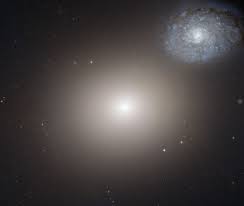The James Webb Telescope, which began science operations earlier this year has finally teamed up with its cosmic brother, the Hubble telescope, in what is one of the most awaited pairings in the scientific community. Data from the two observatories, located outside Earth, have been combined to study interstellar dust.
Nasa released the image that captured two galaxies from data by James Webb and Hubble telescopes and a third, which went unnoticed in the past.
While the JWST looked at the galaxy in infrared light, Hubble peered into the galaxy in visible and ultraviolet light. The data allowed astronomers to trace light that was emitted by the bright white elliptical galaxy through the winding spiral galaxy.
The two telescopes helped identify the effects of interstellar dust in the spiral galaxy in the galactic pair VV 191. “We got more than we bargained for by combining data from Nasa’s James Webb Space Telescope and NASA’s Hubble Space Telescope,” Rogier Windhorst, Webb’s interdisciplinary scientist, said in a statement.
Webb’s near-infrared visuals show the galaxy’s longer, extremely dusty spiral arms in far more detail, giving the arms an appearance of overlapping with the central bulge of the bright white elliptical galaxy on the left.
VV 191 is a superimposed galaxy pair, which is one of 2000 such pairs identified by Galaxy Zoo citizen science volunteers.
“Understanding where dust is present in galaxies is important because dust changes the brightness and colors that appear in images of the galaxies. Dust grains are partially responsible for the formation of new stars and planets, so we are always seeking to identify their presence for further studies,” Windhorst added.
Apart from seeing the galactic pair, the two telescopes also picked up a very distant galaxy whose light is bent by the gravity of the elliptical foreground galaxy. The galaxy appears as a faint red arc just above the pair. Astronomers said that the images of the lensed galaxy are so faint and so red that they went unrecognized in Hubble data, but were easily picked up in Webb’s near-infrared image.
“Like many Webb images, this image of VV 191 shows additional galaxies deeper and deeper in the background. Two patchy spirals to the upper left of the elliptical galaxy have similar apparent sizes, but show up in very different colors. One is likely very dusty and the other very far away, but we or other astronomers need to obtain data known as spectra to determine which is which,” Windhorst said.



